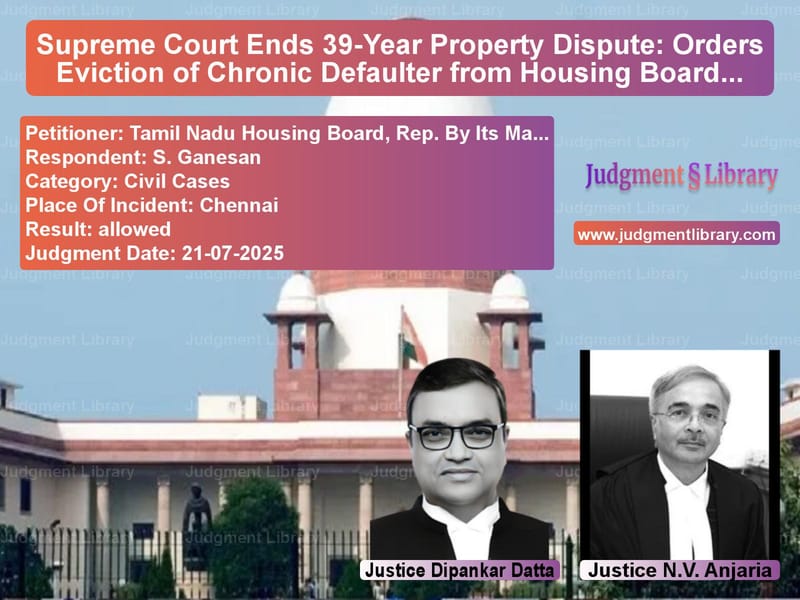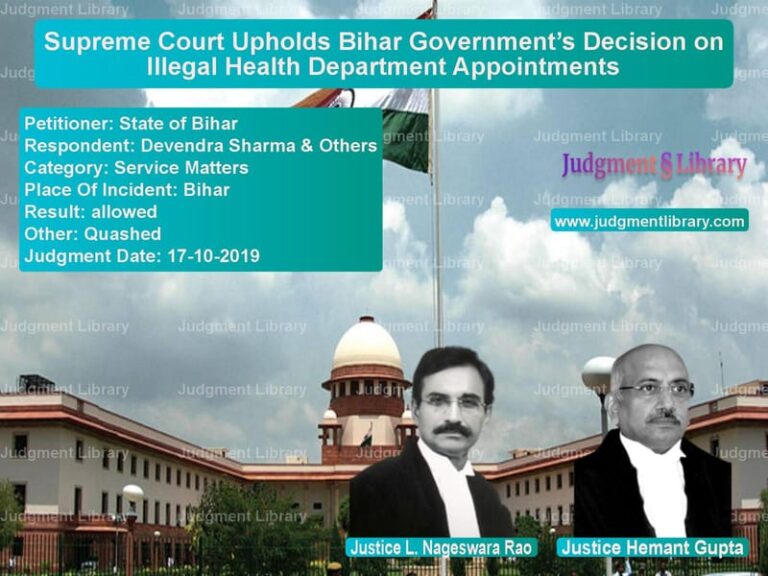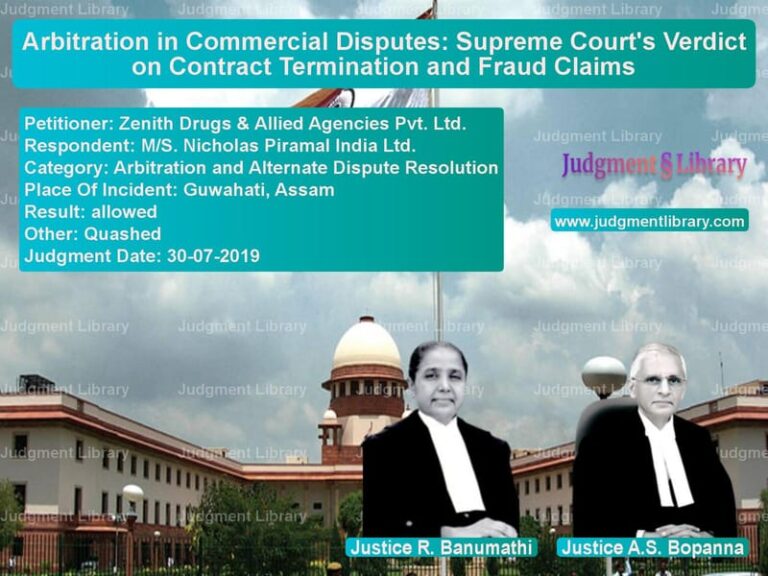Supreme Court Ends 39-Year Property Dispute: Orders Eviction of Chronic Defaulter from Housing Board Plot
In a landmark judgment that underscores the importance of honoring contractual obligations and protecting public property, the Supreme Court of India delivered a decisive verdict on July 21, 2025, bringing closure to a 39-year-long property dispute between the Tamil Nadu Housing Board and S. Ganesan. The case, which began in 1986 when Ganesan successfully bid for a prime commercial plot in Chennai, represents one of the longest-running property disputes in recent legal history and offers important lessons about the consequences of defaulting on payment obligations and the misuse of judicial processes.
The dispute originated on September 23, 1986, when the Tamil Nadu Housing Board conducted an open auction for Prime Commercial Plot No. PC-16 at Razaak Garden Road, Arumbakkam, Chennai. S. Ganesan emerged as the highest bidder with an offer of Rs. 4,78,921. The Board communicated its acceptance of his offer through a letter dated December 23, 1986, requesting him to pay 25% of the bid amount (Rs. 1,19,731) as an initial deposit within 15 days. However, Ganesan failed to make this payment, leading to the cancellation of his allotment on June 1, 1987.
What followed was a series of representations, extensions, and legal maneuvers that stretched over nearly four decades. After multiple representations from Ganesan, the Board exceptionally allowed him to revive the allotment in November 1993, subject to payment of the initial deposit along with 12% interest for 85 months and a revocation fee. While Ganesan paid the initial deposit and revocation fee, he notably avoided paying the interest amount. The Board nevertheless issued a Regular Allotment Order on February 28, 1994, permitting him to pay the balance amount of Rs. 3,57,191 through monthly installments under a Hire Purchase Scheme.
The case took a significant turn in 1998 when the Board inadvertently informed Ganesan that he only needed to pay Rs. 77,300 as the balance amount, which he promptly paid. However, upon detecting this error, the Board recalculated the actual dues and found Ganesan liable to pay Rs. 15,26,023 as of December 2002. When Ganesan failed to pay this amount, the Board cancelled the allotment in July 2004.
This cancellation triggered a series of legal battles, with Ganesan filing multiple writ petitions before the Madras High Court. The litigation saw various interim orders, stays, and opportunities granted to Ganesan to clear his dues. At one point, Ganesan even undertook to pay Rs. 20,77,911 within ten days but failed to honor this commitment. The Board’s attempts to recover the plot were consistently thwarted by Ganesan’s legal maneuvers and failure to make payments despite repeated opportunities.
The matter reached the Division Bench of the High Court, which in its impugned judgment dated January 28, 2025, allowed Ganesan’s writ appeal and set aside the Single Judge’s order. Despite noting that the market value of the property had appreciated to approximately Rs. 4.86 crore, the Division Bench permitted Ganesan to pay Rs. 3 crore in three monthly installments and directed the Board to execute the sale deed upon payment. The Board challenged this order before the Supreme Court.
When the special leave petition came before the Supreme Court on May 19, 2025, the Court directed that the matter be listed on July 21, 2025, and required Ganesan to tender Rs. 3 crore in the interim. The appellants were directed to receive the payment without prejudice to their rights. The Supreme Court explicitly stated that “Obviously, such an opportunity was given to the respondent to test his bona fides.”
However, when the matter came up for hearing on July 21, 2025, Ganesan had failed to make the payment as directed. His counsel sought an extension of time to comply with the order, despite having been given over two months to do so. This failure proved crucial in the Supreme Court’s assessment of the case.
The Supreme Court, in its judgment delivered by Justice Dipankar Datta, expressed strong disapproval of Ganesan’s conduct throughout the prolonged dispute. The Court noted: “At the outset, we need to take serious exception to the conduct of the respondent. He has shown an utterly lackadaisical attitude while dealing with the Board, the High Court as well as this Court. The facts reveal that the respondent has been given sufficient indulgence by the High Court to make the balance payment for the Plot. The respondent has, however, not availed of the opportunity so granted. We do not intend to continue to give leeway to the respondent who has shown continued apathy and indifference with regard to compliance of judicial orders requiring payment to be made.”
The Court emphasized the importance of protecting public property and ensuring that its management prioritizes the greater public good. The judgment stated: “The Plot, being a public property, its management should prioritize the greater public good. The Board, being the custodian of public property, holds it in trust for the public and is under a duty to take decisions regarding it which serves the broader public interest best. It is to be kept in mind that any auction process by any public authority should be above reproach, guided by the principles of transparency, fairness, and reasonableness. The Board is right in stating that the indulgences granted to the respondent has resulted in loss of revenue to the public exchequer on account of inflation in market value of the property from 1986 till date.”
The Supreme Court also addressed the High Court’s criticism of the Board for its initial error in communicating the wrong balance amount. The Court observed: “We also do not approve the decision of the High Court in placing the blame on the Board. True it is, the Board had committed an error in stating that the balance amount owed by the respondent was Rs. 77,300/- instead of the actual figure. However, immediately upon payment of the said amount by the respondent, the Board scrutinised the records and presented the correct figure in a little more than a year. Moreover, the respondent could not have in good conscience believed that the remaining amount was only about Rs. 77,000/- when the original transaction was for Rs. 4,78,921/- and he had admittedly only paid a fraction of the said amount. His conduct seriously calls into question his bona fides.”
The Court further noted that despite Ganesan’s undertaking to pay the balance amount after the Board corrected its error, he failed to honor his commitment. The judgment stated: “Be that as it may, pursuant to the said correction by the Board, the respondent himself undertook to pay the said balance amount. We fail to see how the Board can then be considered to be in the wrong in the instant case.”
The Supreme Court was particularly critical of Ganesan’s failure to comply with the Division Bench’s order to pay Rs. 3 crore in three installments, noting that he only paid the first installment and then sought permission to pay the remaining two installments together. The Court observed: “Despite such disapproval as above, it is significant to note that even after the Division Bench had granted the respondent opportunity to clear the amount of Rs. 3 crore in three equal monthly instalments, only the first instalment was paid within time whereafter permission of the Board was sought by him to pay the remaining two instalments at one go. Although the Board had returned the instalment payment citing its intention to approach this Court, nothing prevented the respondent to show his bona fides by crediting the Board’s account with the balance Rs. 2 crore within the time stipulated notwithstanding the Board’s intention to move this Court. In our considered opinion, given the respondent’s failure to adhere to previous commitments, his offer to pay the balance sum not in two instalments but in a single instalment was too unrealistic to be taken seriously and be deemed practicable.”
In its final ruling, the Supreme Court allowed the Board’s appeal and put an end to the prolonged litigation. The Court noted the extraordinary duration of the dispute and the minimal payments made by Ganesan despite occupying the plot for over three decades: “We, therefore, intend to put an end to this long-drawn litigation, especially considering that the genesis of this dispute originated almost 4 (four) decades ago, in the year 1986. The state of this public property has been in a limbo since then. The respondent has been in occupation of the Plot for a little in excess of 3 (three) decades having paid only Rs. 1,97,031/- (Rs. 1,19,731/- given as initial deposit and Rs. 77,300/- later on) despite he having offered the bid of Rs. 4,78,921/- in 1986. It is now high time that he quits and delivers possession of the Plot to the Board.”
The Supreme Court granted Ganesan four months to vacate the plot and warned that in case of default, the Board would be free to dislodge him with police assistance and recover the balance amount of Rs. 2,81,890 along with simple interest at 6% per annum from the date he was put in possession. The Court also authorized the Board to conduct a re-auction of the plot after obtaining possession.
This judgment serves as a significant precedent in property law, emphasizing that courts cannot indefinitely protect defaulting parties, especially when public property is involved. The Supreme Court’s firm stance against the misuse of judicial processes and its prioritization of public interest over individual convenience sets an important standard for similar disputes. The ruling also highlights the importance of bona fide conduct in contractual relationships and the consequences of failing to honor payment obligations despite repeated opportunities and indulgences.
The 39-year legal saga finally concludes with a clear message: public property must be protected, contractual obligations must be honored, and judicial processes cannot be exploited to indefinitely delay the resolution of legitimate claims. The Supreme Court’s decision ensures that valuable public assets are not held hostage by chronic defaulters and can be put to productive use for the greater public good.
Petitioner Name: Tamil Nadu Housing Board, Rep. By Its Managing Director And Ors..Respondent Name: S. Ganesan.Judgment By: Justice Dipankar Datta, Justice N.V. Anjaria.Place Of Incident: Chennai.Judgment Date: 21-07-2025.Result: allowed.
Don’t miss out on the full details! Download the complete judgment in PDF format below and gain valuable insights instantly!
Download Judgment: tamil-nadu-housing-b-vs-s.-ganesan-supreme-court-of-india-judgment-dated-21-07-2025.pdf
Directly Download Judgment: Directly download this Judgment
See all petitions in Property Disputes
See all petitions in Contract Disputes
See all petitions in Debt Recovery
See all petitions in Landlord-Tenant Disputes
See all petitions in Specific Performance
See all petitions in Judgment by Dipankar Datta
See all petitions in Judgment by N.V. Anjaria
See all petitions in allowed
See all petitions in supreme court of India judgments July 2025
See all petitions in 2025 judgments
See all posts in Civil Cases Category
See all allowed petitions in Civil Cases Category
See all Dismissed petitions in Civil Cases Category
See all partially allowed petitions in Civil Cases Category







